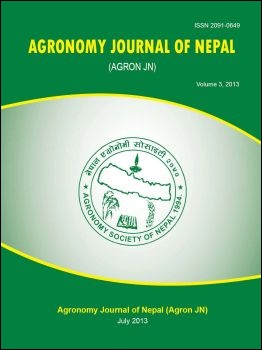Food security scenario, challenges, and agronomic research directions of Nepal
DOI:
https://doi.org/10.3126/ajn.v3i0.8985Keywords:
agronomic crops, agronomic research direction, food securityAbstract
The interim constitution of Nepal has mentioned “food sovereignty as fundamental right in its constituents 18.3". However, Nepal is experiencing decline in food security situation due to collision of domestic, national and international crises viz. poor agricultural growth, declined national agricultural priority, global climate change, global food crisis, and political instability. There is domination of small and marginal holders in Nepalese agriculture. Although the share of agriculture in country’s GDP is decreasing, it is still 33%, and the highest among the South Asian countries. Cereals are the most important staple food crops in Nepal and rice number one from area and production followed by maize, wheat, millets and barley. The grain-legumes and potatoes are considered the protective food crops for the maintenance of balance human nutrition in Nepal. Out of 88 countries, Nepal ranked 57th in Global Hunger Index (GHI) with GHI value of 19.8 depicting alarming situation of hunger in different regions of the country. Since the III Five year plan (1975- 80), the government of Nepal has given high priority in agriculture, focusing major approaches on promotion of integrated farming systems to address food and nutrition security. However, the food security situation is deteriorating. Adaptive measures on climate change, food distribution policy, crop and livestock insurance, subsidies on fertilizers and seeds, research and development activities on food-grain crops and bio-diversity conservation, inter agency coordination, food and seed buffer stock, and institutional capacity building would the viable options to maintain the food security in Nepal. From the rigorous study of various past research works, it can be concluded that the wider gap of several food grain crops can be reduced by system research, crop modelling, and up-scaling the use of agricultural machineries and tools.
Agronomy Journal of Nepal (Agron JN) Vol. 3. 2013, Page 42-52
Downloads
Downloads
Published
How to Cite
Issue
Section
License
ASON permits for free use, distribution and reproduction in any medium if the original work is properly cited and not used for commercial purposes.




